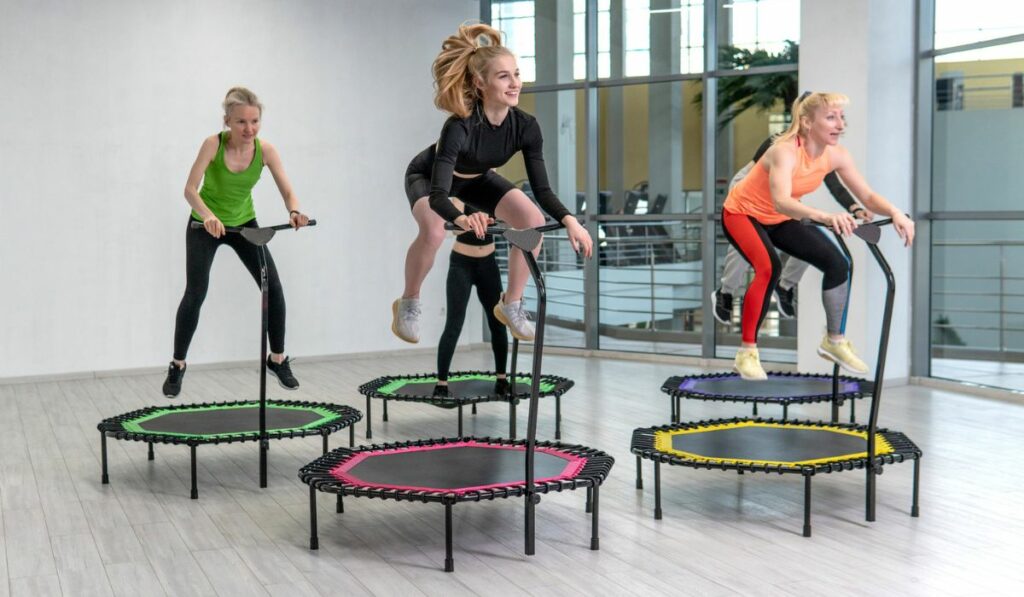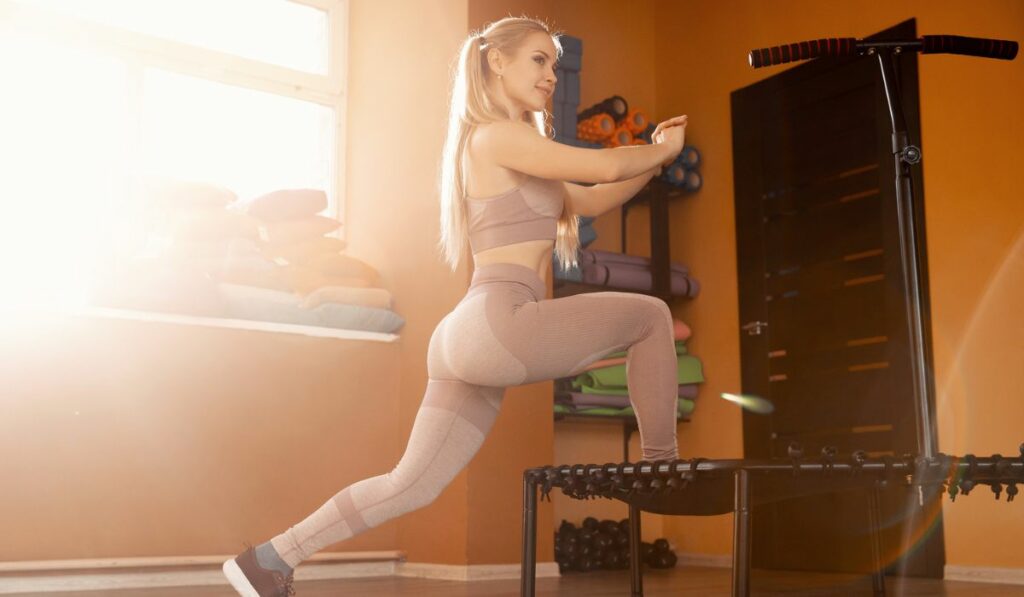According to NASA’s Journal of Applied Physiology, jumping on a trampoline is a more effective workout than a half-hour jog. An American Council on Exercise (ACE) study also found that a 20-minute trampoline workout session burns the same amount of calories as running for 20 minutes does. So, should you add some time on the trampoline to your workout routine?
Adding a trampoline to your workout routine can improve cardiovascular health, relieve tension, improve bone density, and help with your balance, coordination, and motor skills. Some of the best trampoline workouts include squat jumps, tuck jumps, jumping jacks, pelvic floor jumps, and seat drops.
Jumping on a trampoline as part of your exercise routine may seem too good to be true, but its numerous health benefits are no myth. Let’s look at how you can benefit from trampoline exercises, which muscles the routine will work, and which trampoline workouts are the best, so that you can incorporate a bit of fun into your daily exercise routine.
What Are the Benefits of Trampoline Exercise?

While it might not seem like it, jumping on a trampoline is an intense full-body workout, and you can even get a relatively compact trampoline — like this one (on Amazon) — that’ll fit in your home gym.
Here are a few proven health benefits of trampoline exercise:
Improves Cardiovascular Health
Cardio activity decreases the amount of stress on your heart, strengthens cardiac muscles, and makes it easier for your body to pump and distribute blood.
This, in turn, lowers your resting heart rate, triglyceride levels, and cholesterol levels — all positive developments for your overall cardiovascular health.
Helps With Balance, Coordination, and Motor Skills
As we age, our bone density decreases, increasing the risk of getting seriously injured during a fall. However, a study found that after exercising on a mini-trampoline for 14 weeks, the ability of seniors to regain their balance before taking a hard fall increased by around 35%.
This means that rebounding helps improve coordination, motor skills, and balance, making it especially beneficial for people who are at a greater risk of falling.
Relieves Tension
In general, exercise has a strong association with stress relief because it helps release endorphins, which are natural substances that make you feel happier and help you maintain a positive attitude.
Since jumping on a trampoline impacts your entire body, it significantly reduces your stress levels. All the jumping causes you to continuously release and tense your muscles, which helps improve circulation. Then, once you’re done jumping, your muscles become loose and relaxed.
Builds Strength
Unlike targeted training, jumping exercises several different muscles. When you jump on a trampoline, you use the momentum of your entire body, forcing various muscles to work at the same time.
The continuous ups-and-downs exercise everything from your glutes and abs to your back and leg muscles, strengthening your core and beyond.
Improves Bone Density
Bones become more fragile and brittle with age, so it’s extremely important to do a few exercises that improve bone density. Luckily, a trampoline workout routine can help you out in this aspect.
In fact, according to a study, competitive trampolinists have a higher bone density at the spine and hip than their peers. While most people don’t have the same routine as competitive trampolinists, the data suggests that regularly jumping on a trampoline can strengthen your bones and reduce the risk of osteoporosis.
What Muscles Does a Trampoline Work?
Jumping on a trampoline works the entire body, and the g-force produced by all the bouncing helps burn fat and build muscle. Along with exercising the muscles in your thighs, hips, stomach, legs, and arms, a trampoline workout routine also helps improve balance and agility.
Trampoline jumping especially works your leg muscles, as they have to continuously push you upwards by counteracting gravity. Intense, repetitive jumping further means that your muscles release and contract much more frequently than almost all other exercise routines, helping to tone and strengthen them at the same time.
Since you’ll be twisting your body to move and maintain your balance in the air, jumping will train your core and stomach muscles as well. Your back muscles and abs will also contract every time you jump and come back down to the mat.
It’s important to note that aside from muscles, jumping on a trampoline also works tendons, ligaments, and joints, making the workout routine perfect for people with mild arthritis.
What Are the Best Trampoline Workouts?
Trampoline workouts are an extremely enjoyable and convenient way to improve your endurance, relieve stress and tension, and boost cardiovascular health. Studies also show that jumping on a trampoline positively affects bone health and helps improve bone strength and density.
To help you take full advantage of the numerous benefits of trampolining, here are some trampoline workouts you can incorporate into your daily exercise routine:
Squat Jumps
- Stand with your arms along your body and your feet directly under your hips.
- Jump on the trampoline and spread your feet until they’re wider than your hips.
- Land back on the mat in a squat position.
- Bend both your knees so your thighs are perfectly parallel to the floor.
- Hold your arms out in front of you.
- Stand back up and return to your starting position.
- Do anywhere from one to three sets of 8-12 repetitions.
Tuck Jumps
- Jump on the trampoline and tuck your knees close to your chest.
- Perform a recovery jump once you land back on the mat.
- After getting the hang of it, tuck your knees with every jump.
- Continue this routine for 1-3 minutes.
Jumping Jacks
- Position your feet together and keep your arms loose alongside your body.
- Lift both your arms overhead and move your feet apart with every jump.
- Jump back to your original starting position.
- Continue this workout for 1-3 minutes.
Pelvic Floor Jumps
- Position a small exercise block or ball between your knees.
- Gently and slowly jump up and down.
- Try to engage your pelvic muscles with every jump.
- Engage your inner thighs by squeezing the ball.
- Continue this routine for 1-3 minutes.
Seat Drops
- Jump on the trampoline and extend both of your legs straight out in front of you.
- Keep your legs extended until you land down on the mat.
- Keep your palms down for additional support.
- Jump back to your original position.
- Continue this workout for 1-3 minutes.
Twists
- Stand on the trampoline with your feet under your hips and hold your arms loosely alongside your body.
- Jump and twist your torso to the right as you turn both your legs to the left.
- Return to your original position upon landing on the mat.
- Jump up and rotate your torso to the left as you turn both your legs to the right.
- Do one to three sets of 8-16 repetitions.
Pike Jumps
- Jump on the trampoline and extend your legs out in front of your body.
- Extend your arms out as well and try to touch your feet with your hands.
- Continue this routine for 1-3 minutes.
Single-Leg Bounces
- Stand on the trampoline with your feet spaced hip-distance apart.
- Put all your weight onto your right foot and lift your left foot.
- Jump on the trampoline for up to two minutes.
- Repeat these steps with the opposite leg.
Jogging Variations
- Jog from one side of the trampoline to the other a few times.
- Then jog with a wider stance.
- Try jogging with both your arms overhead.
- Jog sideways from one side to the other.
- Spend 1-2 minutes on every variation.
Tips for Preventing Injury

While jumping on a trampoline can be extremely beneficial, make sure you take a few safety precautions before incorporating this recreational activity into your workout routine.
Here are some tips that can help you prevent injury:
- Always use a trampoline that has a handlebar, safety rail, or safety net for additional protection.
- If you’re using a trampoline at home, make sure it’s positioned far away from sharp corners, hard objects, and furniture. If you’re in a small space, consider buying an outdoor trampoline.
- Maintain good posture by keeping your neck, head, and spine in alignment. Make sure your head doesn’t move to the side, front, or back.
- Don’t lock your knees, instead jump by slightly bending them.
- Wear quality shoes for additional support.
- Consult your doctor before performing any trampoline exercises, especially if you have medical conditions, take any medications, or suffer from any injuries.
- Stop jumping at once if you feel faint, experience pain, or have difficulty breathing.
- You might feel a bit lightheaded or dizzy when you first begin. In this case, stop jumping and sit down for a few minutes until you return to normal.








